Bracket Braces: Ultimate Patient Guide
Orthodontic Parts: Learn More

Bracket braces are usually how patients start their journey toward a straighter and healthier smile. These metal brackets, wires, bands, and other parts of braces are often used in orthodontics.
Orthodontists like Dr. Dallam at Augusta Orthodontics precisely use these little parts to realign teeth, correct bites, and transform Augusta residents’ oral health.
Let’s dive into the various parts of orthodontia, what orthodontists do for patients, and the unique experiences patients have while undergoing treatment.
Standard Braces
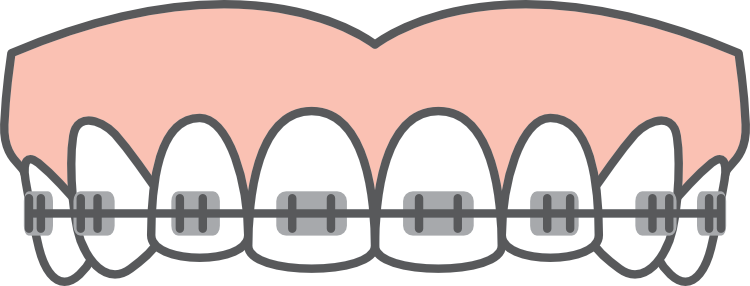
Braces for teeth is a system of several different dental parts used together. This combination of parts, when used together, gently moves teeth into the perfect position. These components include brackets, archwires, bands, elastics, and more. Braces work by safely pushing and pulling teeth under controlled pressure, gradually guiding them into their ideal positions over time.
This can be for children as teeth grow in or for adults whose teeth have moved or need fixing.
Patient Experience: With bracket braces, in-office adjustment appointments every few months are necessary. The potential for discomfort during the initial days and briefly after an adjustment appointment is possible as your mouth adapts.
Metal Bracket Braces
Metal Brackets for braces are the classic, standard, strongest choice. The braces brackets are made from high-grade stainless steel. That is why they are so strong!
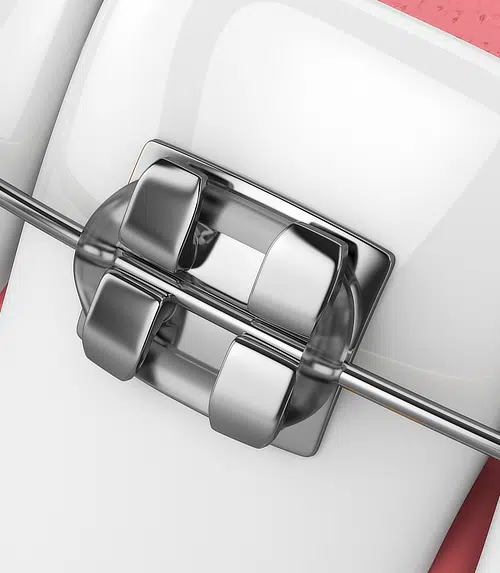
They are sturdy and effective, durable, and can withstand treatment demands. Patients who choose silver brackets enjoy the reliability and efficiency they offer.
- Patient’s experience: The grey braces color is noticeable, but the modern techniques and parts used at Augusta Orthodontics keep this minimal.
Ceramic Brackets
Ceramic brackets provide a discreet alternative to metal. Made from translucent or tooth-colored materials, they blend seamlessly with your teeth.

Patients appreciate the aesthetics of ceramic brackets, as they are less noticeable. However, they may be slightly more delicate than their metal counterparts, requiring careful maintenance to avoid staining or breakage.
- Patient experience: Differs from silver braces because ceramic braces are less visible. This is especially true in everyday photographs when tooth-colored brackets will be less noticeable. In contrast, ceramic braces are attractive to certain patients as they amplify the patient’s selected colored rubber band combination.
Clear Brackets
Clear brackets take the subtlety of ceramic to the next level. Sometimes called “plastic brackets,” these are made from a crystal-clear material that is not plastic.

Clear brackets take the subtlety of ceramic to the next level. Sometimes called “plastic brackets,” these are made from a crystal-clear material that is not plastic.
These are so transparent they are barely noticeable on the teeth. Some patients say only the thin archwire can be seen.
It’s important to note that clear brackets are more prone to discoloration. Therefore, patients need to maintain good oral hygiene to avoid staining.
- Patient experience: The unnoticeable nature of crystal clear brackets allows patients to undergo treatment at the highest level of discreetness.
Gold Plated Brackets
For a touch of style and luxury, patients opt for gold-plated brackets. Gold brackets are still made of steel, so they are as strong as metal braces.
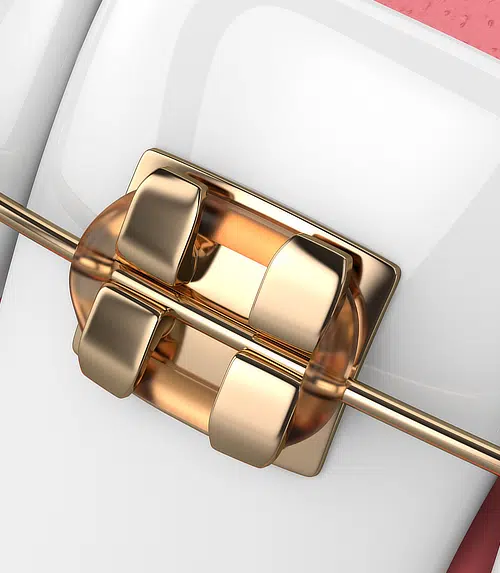
These brackets offer the same functionality as traditional metal silver brackets but with a touch of style.
- The Patient Experience: Patients will enjoy a unique aesthetic appeal with gold braces.
Archwires for Braces
Archwires connect your brackets. Connecting the brackets provides the necessary force to guide teeth into their desired positions. The wires play a key role in any braces bracket treatment.

These wires come in various materials, including stainless steel and nickel-titanium.
Braces wire also comes in different colors too. However, these wires typically need to match the brackets because they are premade to match one another.
- Patient experience: Archwires are normally thin and partially covered by rubberbands, so visibility is low. Patients may feel discomfort or pressure as archwires are adjusted during or after appointments.
O-Rings
O-rings, also known as ligatures, secure archwires to brackets. They come in various colors. This allows patients to personalize their braces.

A popular choice for colors usually matches the braces. For example, clear or ceramic braces get clear o-rings for a less noticeable look. Or, gold braces will get gold bands to match. However, there are no standard guidelines. The best thing to do is try a few different styles until you find the one you like best.
While the placement of new O-rings might cause minor discomfort, this sensation fades quickly. In fact, this “discomfort” is usually non-existent for most patients.
- Patient Experience: This is when our patients get to show off their style. They can select a wide range of color combinations, from red and green bands for holidays or matching for their school colors.
Rubberbands / Elastics
Rubberbands or elastics are used to correct bite issues by applying specific forces between the upper and lower teeth. The bands are removable and can be replaced by the patient. When eating, patients will remove and replace when they’re finished. Additionally, these elastics bands are only worn when you’re awake.

Typically, these bands are only used for short periods of orthodontic treatment, not the entire braces treatment length.
- Patient Experience: Patients will initially find it challenging to adjust to the feeling of elastics because it is pulling their upper and lower teeth together. Don’t worry, it becomes a routine part of treatment over time.
Orthodontic Springs
Orthodontic springs are dynamic parts. The springs help correct specific tooth movements. This means they are usually focused on moving one tooth.
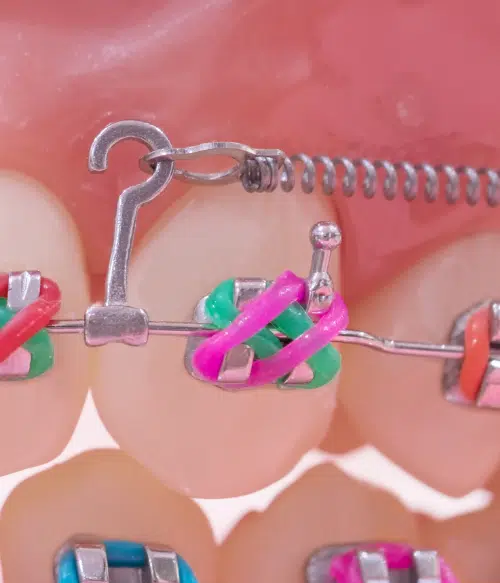
The spring creates an additional force to move the tooth in the desired direction. One end of the spring will attach to the bracket of an opposing tooth, acting like an anchor. There are three types of springs: Retraction, Distalizing, and Opening.
Patients feel pressure or tightness when springs are used, and these sensations generally subside as teeth adjust. They will also feel the spring on the inside of their cheek, but this also subsides as patients get used to it.
- Patient Experience: Ortho springs will be visible and often used on the side teeth. The springs usually match the color of the braces system used.
Molar Bands
Bands, or molar bands, are metal rings that fit around the back first molars. These are not rubber bands.
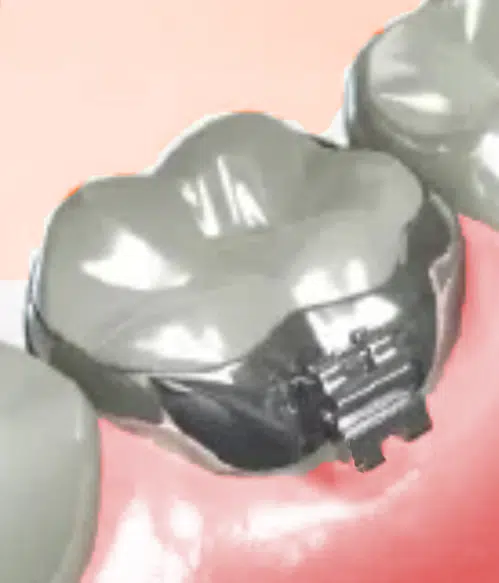
The bands provide an anchor for all the other components. Think of these as the foundation of braces. They can be made from metal or ceramic and wrap around the back molars. The band will also flush with the tooth, preventing food between the tooth and the bracket.
These are used for every orthodontic patient. Brackets are normally used instead.
- Patient Experience: These can’t be seen because they go on the back teeth. The patients will feel a snug sensation when the bands are initially placed. However, they quickly get used to it. Once placed, these are not adjusted often because they are the foundation of your braces treatment.
How are bracket braces put on?

Orthodontic braces will use most, if not all, of these bracket braces components. Patients should become familiar with each type and know what to expect.
The brackets are bonded to teeth with an orthodontic cement material, the wire is clipped in and secured with o-rings, and rubberbands and/or springs are attached.
At Augusta Orthodontics, make this process simple, affordable, and fast. In fact, you can get braces on the same day! On the other hand, every patient is different so we personalize every treatment plan and take the time to ensure you receive the highest standard of dental care.
To provide the best possible outcome, we know that each of the ortho parts above plays a critical role in achieving a beautiful smile and optimal oral health.
While some parts might take a bit of getting used to, the result is life-changing – a confident and straight smile, which is well worth the journey.
Dr. Dallam will gently guide you (and your teeth) through the process, ensuring that each part contributes to your unique treatment plan.